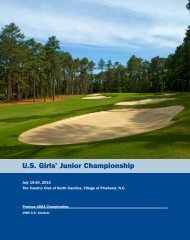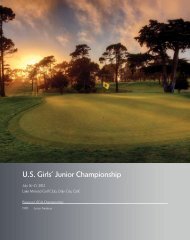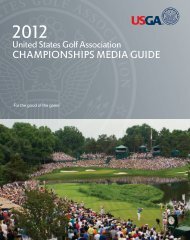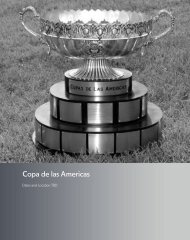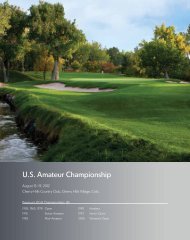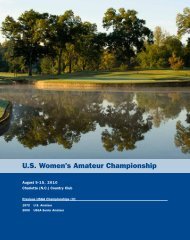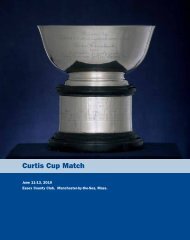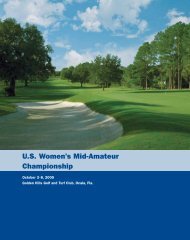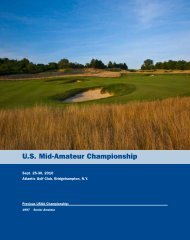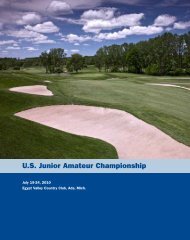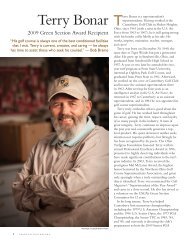0902 Record.indd - USGA
0902 Record.indd - USGA
0902 Record.indd - USGA
Create successful ePaper yourself
Turn your PDF publications into a flip-book with our unique Google optimized e-Paper software.
SponsoredResearchYou Can UseInvestment Yields BermudagrassCultivars with High Quality andImproved Cold-HardinessOklahoma State University scientists continue to improvethis crucial turfgrass for the golf course industry.BY DENNIS L. MARTIN, YANQI WU, JEFF A. ANDERSON,MICHAEL P. ANDERSON, GREGORY E. BELL, AND NATHAN R. WALKERSince its inception in 1986, the bermudagrass breeding and development program at Oklahoma State University has released fi ve cultivarswith improved quality and winter-hardiness. These cultivars have reduced the risk of winterkill when using bermudagrass in the transitionzone. An extensive bermudagrass germplasm collection has been formed, breeding populations improved, and a steady stream of promisingexperimental lines has been developed. Dr. Yanqi Wu, turf/forage/biofuels breeder, examines fl owers of experimental bermudagrass lines ina fi eld space planting.Bermudagrasses (Cynodon spp.) arethe most widely used turfgrassesfor golf courses, athletic fields,and lawns in the southern U.S. Toleranceto close mowing, as well as favorableheat, drought, and traffic toleranceand few serious pests makes bermudagrassan attractive choice in tropicaland subtropical areas. Although widelyadapted, its susceptibility to freezeinjury has been a continuing threat inmany areas of its use. Thus, there hasbeen a long-term need for high-qualitybermudagrasses that have reduced riskof winterkill.Oklahoma State University (OSU)began a joint venture in 1986 with the<strong>USGA</strong> to improve the cold-hardiness,
Table 1Turfgrass cultivars released by the Oklahoma State Universitybermudagrass development program.Year Propagation PloidyCultivar Released Method LevelGuymon 1982 Seed TetraploidMidlawn* 1991 Vegetative TriploidMidfi eld* 1991 Vegetative TriploidYukon 2000 Seed TetraploidRiviera 2001 Seed TetraploidPatriot 2002 Vegetative Tetraploid* Midlawn and Midfi eld were developed by the Kansas State University turf program andwere jointly released with Oklahoma State Universityas well as the visual and functional performancequalities, of seeded bermudagrasses.At that time, the only choicesavailable for seeded bermudagrasscultivars were the less-winter-hardyArizona Common (C. dactylon var.dactylon) or the more cold-hardy butcoarse-textured Guymon (C. dactylonvar. dactylon). The bermudagrass breedingeffort at OSU eventually grew toencompass vegetatively propagatedtypes, as well as seeded grasses. Thisarticle provides a brief overview of theOSU turf bermudagrass developmenteffort.HISTORYCollection of Cynodon germplasm forculture and scientific use began aroundthe start of the 20th century in SouthAfrica and the United States. Bermudagrassgermplasm collection and taxonomiccharacterization at OSU wasTable 2The Oklahoma State University bermudagrass breeding anddevelopment team has expertise in several crucial areas.Current team members and their areas of expertise are listed below.Faculty WorkingGroup MemberCharles TaliaferroYanqi WuDennis MartinJeff AndersonMike AndersonGreg BellNathan WalkerTom RoyerArea of ExpertiseTeam Coordinator (retired), Breeding & GeneticsNew Coordinator, Breeding & GeneticsCultural ManagementPhysiology & Cold ToleranceMolecular Biology & GeneticsCultural Management, Herbicide & Shade TolerancePlant Pathology, Entomology & Molecular BiologyEntomologyunderway in the 1950s and ’60s withnoted accomplishments by Drs. JackHarlan, Johannes de Wet, and WayneHuffine. Turf bermudagrass improvementbegan in earnest in 1986 underthe direction of Dr. Charles Taliaferro.The initial broad objective was todevelop finer-textured, seed-propagated,cold-tolerant bermudagrasses(C. dactylon var. dactylon) for the U.S.transition zone. The initial effortsinvolved collecting additional germplasm,characterizing appearance andperformance, improving the fertilityand texture of breeding populationsthat were known to be cold tolerant,and improving the cold-hardiness inpopulations known to be highly fertile.By 1990, the effort at OSU wasexpanded to include the development ofhigh-quality, cold-hardy, vegetativelypropagatedmaterials for golf coursefairways/tees and to examine the possibilityof generating improved Africanbermudagrasses (C. transvaalensis) foruse on putting greens. Field plantingsof improved African bermudagrassesin tropical areas of the U.S. revealedthe species performed well in fall,winter, and spring but declined substantiallyin the summer months inboth tropical and the more southernsubtropical planting sites. Many Africanbermudagrass selections also sufferedsubstantially more nematode problemson the sandy gulf coastal plain comparedwith the interspecific hybridTifdwarf (C. dactylon X C. transvaalensis)and its derivatives. Although by early1997 efforts to generate putting greentypes of African bermudagrass werediscontinued, the breeding and selectioneffort in that species resulted inimproved types that had value in generatingimproved interspecific hybridcrosses (C. dactylon X C. transvaalensis)for the golf turf industry.Dr. Taliaferro led the turf and foragebermudagrass breeding and developmenteffort from its inception until hisretirement in January 2006. Guymon,Yukon, Riviera, and Patriot turf bermudagrasses(Table 1), as well as anumber of promising experimentaltypes (still under study) were developedunder his leadership. Additionally, hisfamiliarity with cultivar developmenthelped facilitate cooperative releasesof Midlawn and Midfield hybrid bermudagrassesbetween Kansas StateUniversity (KSU) and OSU in 1991(Table 1). Midlawn and Midfield weredeveloped by Dr. Ray Keen of KSUwith field-testing assistance by Drs.John Pair, Jeff Nus, and others.The successes of the OSU turf bermudagrassdevelopment program arenot only due to <strong>USGA</strong> investment, butcan also be attributed to the leadershipof Dr. Charles Taliaferro in concertwith a number of past and current faculty(Table 2), staff, graduate students,and cooperating industry scientists.Following the retirement of Dr.Taliaferro, an extensive search wasconducted that resulted in the hiring
Table 3Mean turfgrass quality ratings of seeded bermudagrasses during 2006from 9 transition-zone locations, 2002-2006 NTEP Bermudagrass Trial.*Seeded Entryof Dr. Yanqi Wu in July 2006 to headup the OSU bermudagrass breedingand development effort. Dr. Wu completedhis Ph.D. under the tutelage ofDr. Taliaferro in 2004. A substantialportion of the newer bermudagrassgermplasm in our program was collectedby and is in an ongoing state ofcharacterization by Dr. Wu.BERMUDAGRASSCULTIVARSDEVELOPED AT OSUIn 1982, preceding the <strong>USGA</strong>-fundedturf development effort at OSU, theforage/pasture effort resulted in therelease of Guymon bermudagrass (C.dactylon var. dactylon) (Table 1). GuymonMeanYukon 6.2Riviera 5.8Contessa 5.8SWI-1046 5.7SWI-1012 5.7SWI-1044 5.6CIS-CD6 5.4Veracruz 5.4SWI-1014 5.4CIS-CD7 5.3SWI-1003 5.2Sunbird 5.1SWI-1001 5.1Princess 77 5.0Tift No. 2 5.0Transcontinental 5.0CIS-CD5 4.9Tift No. 1 4.8SR 9554 4.8Panama 4.7LaPaloma 4.7FMC-6 4.7Arizona Common 4.7Southern Star 4.7NuMex Sahara 4.6Mohawk 4.6Sundevil II 4.5Sunstar 4.5B-14 4.5LSD (0.05) 0.3Coeff. of variation (%) 12.30* Excerpted from Tables 3b, p. 14, of the 2006 NTEP Progress Report NTEP No. 07-6.Quality rated on a 1-9 scale, where 1 is poor and 9 is excellent.was arguably the first seeded bermudagrasswith improved cold-hardiness overArizona Common. Guymon foundfavor in soil erosion control areas, roadsides,rangeland, and pastures. Withonly the non-cold-hardy ArizonaCommon bermudagrass seed beingavailable during the 1980s, the coarsetextured,but cold-hardy and vigorousGuymon was often used on lowermaintenancesports fields and lawns inthe transition zone.Yukon bermudagrass (C. dactylonvar. dactylon), tested as OKS 91-11, wasreleased in 2000. It was the first turfbermudagrass from OSU developedwith grant funding from the <strong>USGA</strong>.Yukon is a high-quality seeded turftypebermudagrass with improvedcold-hardiness and improved springdead spot disease tolerance.Yukon found favor on some golfcourses, sports fields, and in the lawn/landscape industry. It performs well atthe 0.5-inch mowing height typicalof bermudagrass fairways. The divotrecovery rate of Yukon varies fromintermediate to rapid. Although Yukonseed availability has been limited inrecent years, increased availability ofseed is anticipated in the near future.Yukon continues to provide excellentquality in transition-zone climates(Table 3).Riviera bermudagrass (C. dactylonvar. dactylon), tested as OKS 95-1, wasreleased in 2001. Riviera is a highquality(Table 4), medium-fine-texturedseeded bermudagrass. Rivieraseed production yields are typicallyhigher than those of Yukon. Rivierahas improved cold-hardiness andimproved tolerance to spring deadspot. The Riviera divot recovery ratevaries from intermediate to rapid.Riviera is now receiving increased useon fairways, tees, athletic fields, andlawns when a high-quality seededbermudagrass with improved coldhardinessis desired.Patriot bermudagrass (C. dactylon XC. transvaalensis), tested as OKC 18-4,was released in 2002. Patriot is a vegetativelypropagated hybrid characterizedas having improved color, quality(Table 4), and cold-hardiness. Its divotrecovery rate has been characterized asmedium to rapid. Licensed producershave reported rapid sod productioncycles from planting to harvest.Improved tolerance to spring dead spotdisease is also a desirable characteristicof Patriot. We believe Patriot to bethe first commercialized interspecifichybrid turf-type bermudagrass that is atetraploid. It was created by a crossof the hexaploid Tifton 10 and animproved African bermudagrass (adiploid) from our collection. Patriot iswell adapted to golf course tee andfairway use and is currently experienc-
Table 4Mean bermudagrass quality from multiple locations during the1997-2001 National Turfgrass Evaluation Program Bermudagrass Trial.*Entry Regime A** Regime BArizona Common 4.7 4.5Blackjack 5.3 5.4Blue-Muda 5.1 5.0Cardinal 5.4 5.7CN 2-9 6.1 5.8J-540 5.3 5.2Jackpot 5.0 4.9Majestic 5.3 5.3Midlawn 5.8 6.5Mini-Verde 5.6 5.1Mirage 5.1 4.9NuMex-Sahara 5.0 5.0OKC 19-9 5.8 6.1Patriot 6.1 6.6Princess 77 6.5 6.1Pyramid 5.2 5.0Riviera 6.4 6.6Savannah 5.4 5.3Shanghai 5.6 6.1Shangra La 5.2 5.1Southern Star 5.4 5.4Sundevil II 5.3 5.0SWI-11 6.1 5.5Sydney 5.2 5.2Tifgreen 6.1 6.3Tifsport 6.5 6.1Tifway 6.4 6.2Transcontinental 6.0 5.6LSD (0.05) 0.2 0.2Coeff. of variation 14.00 14.90** Excerpted from Tables 1a and 2a of the 1997-2001 NTEP Bermudagrass Trial Final ReportNTEP No. 97-9. Quality rated on a 1-9 scale, where 1 is poor and 9 is excellent.** The 9 Regime A trials were mowed at 0.5 to 0.75 inch and fertilized with 0.75-1 lb. of Nper 1,000 sq. ft. per growing month. The 11 Regime B trials were mowed at 0.75 to 1.0inch and fertilized with 0.5-0.75 lb. of N per 1,000 sq. ft. per growing month. Both regimesincluded irrigation to prevent visual drought stress.ing increased use by the golf courseindustry.EXPERIMENTAL OKLAHOMASELECTIONS WITH PROMISEOKC 70-18 bermudagrass, developedin part with funding from the <strong>USGA</strong>,has recently undergone intensiveinternal as well as external testing(2002-2006 NTEP bermudagrass trial).This variety ranked first in overallquality at nine transition-zone test sitesduring several years of the 2002-2006NTEP trial. OKC 70-18 has severalmeritorious characteristics, and adecision concerning possible release isforthcoming.Three promising experimental bermudagrassesfrom our program wereentered into the 2007-2011 NTEPbermudagrass trial. These includedOKC 11-19 and OKC 11-34, vegetativelypropagated types and a seededtype, OKS 2004-2. Sixteen NTEPtesting sites are in place for the 2007NTEP trial. Besides the traditionalparameters of color, quality, texture,density, green-up, and living cover,additional parameters monitored atselected sites will include sod tensilestrength as well as tolerance to springdead spot disease, salinity, and traffic.CURRENTBREEDING ANDDEVELOPMENT WORKA new broad-based breeding populationwas recently formed using desirableChinese Cynodon material selectedfrom a collection by Dr. Wu made in11 provincial regions of China. Selectionswere made based on extensiveevaluation of chromosomal, morphological,seed yield potential, and DNAmarker investigations completed in2004. The population contains favorabletraits for turf cultivar development,including darker green color, relativelyfine texture, good winter-hardiness,and good sod density. Study of geneticrelatedness assists the turf breeder inelimination of possible duplication ofbreeding efforts due to close relatednessof parents. Additionally, this workmay help in locating crosses that haveincreased likelihood of compatibility.Complementary to this work, Dr.Kevin Kenworthy (now of the Universityof Florida Turfgrass Program)recently completed an assessment ofthe variability in 21 performance traitsof African bermudagrass while in ourprogram. The work determined whichtraits can most easily be improved inthe African bermudagrass parents thatare subsequently useful for developinginterspecific crosses.Applied field trials comparing laterstagepromising experimental entriesand industry standards are ongoing forturf quality, divot recovery, springdead spot resistance, and sod tensilestrength. Due to inability to eradicatepre-existing aggressive C. dactylon var.dactylon types from many installationsites, some superintendents choose notto renovate to improved bermudagrasscultivars. In order to address this issue,a preliminary study investigating theresistance of hybrid bermudagrasses toencroachment by common bermudagrasswas initiated in 2006 by M.S.candidate Holly Han.
Above left: An interspecifi c hybrid and an aggressive common bermudagrass “duke it out” during the establishment phase. Inability to eradicate on-siteaggressive common bermudagrass leads to mixtures with diminished playing surface quality. Work is underway at Oklahoma State University to determine ifrapid-spreading improved types can better compete against common bermudagrass. Above right: Patriot is a high-quality, vegetatively propagated, interspecific hybrid bermudagrass with improved cold-hardiness and rapid divot recovery rate.ADDITIONALBERMUDAGRASSPERFORMANCEFEATURESDevelopment of bermudagrasses withhigh turf quality and suitable coldhardinesswill remain a key focus ofour efforts, although pursuit of additionalimprovements has begun.Limited freshwater resources threatenthe vitality of the golf turf and landscapeindustries. Work commenced inlate summer 2007 by M.S. candidateSantanu Thapa to evaluate the wateruse rate of several experimental OSUbermudagrasses. Evaluation of leaffiring resistance under drought willalso be incorporated into our screeningprogram in future years. Developmentof bermudagrasses with delayed leaffiring may help superintendents maintainquality turf during periods oflimited natural rainfall and duringirrigation restrictions.Lack of suitable shade tolerance isa key limitation of bermudagrass. Asthe golf course landscape matures,increased shading of turf occurs.Breeding and selection for improvedshade tolerance in bermudagrass hasbeen successfully conducted by turfgrassscientists at the University ofGeorgia. Screening of bermudagrassgermplasm for improved shade tolerancewas initiated in the summer of2007 by Drs. Greg Bell and Yanqi Wu.The work incorporates the use of acombination of natural and artificialshade.CONCLUSIONS<strong>USGA</strong> support has been instrumentalin supplementing a long-term turfbermudagrass development effort atOklahoma State University. A comprehensive,interdisciplinary team ofscientists has been assembled, focusingon turf bermudagrass improvement.The effort has resulted in extensivecollection, characterization, andimprovement of breeding populationsof bermudagrasses from the Cynodondactylon and C. transvaalensis species.Studies have aided in the understandingof fundamental mechanismsof stress tolerance. Improvements havebeen made in turf quality, cold-hardiness,and spring dead spot tolerance.The improved turf bermudagrassesYukon, Riviera, and Patriot weredirect results of the <strong>USGA</strong> investment.Training a number of graduate studentscan also be attributed to <strong>USGA</strong> contributions.Two clonally propagated selectionsand one seed-propagated selectionwith improved characteristics for thegolf industry were entered into the2007 NTEP bermudagrass trial. Newgermplasm from China has recentlybeen introduced into our program.Incorporation of increased water useefficiency, leaf firing resistance underdrought, and improved shade tolerancein bermudagrass are future goals of ourdevelopment effort.ACKNOWLEDGEMENTSThe authors wish to thank the <strong>USGA</strong>Turfgrass and Environmental ResearchProgram for support of this researchand development program. We alsogratefully acknowledge support of theOklahoma State University AgriculturalExperiment Station and theOklahoma Turfgrass ResearchFoundation.EDITOR’S NOTE: An expanded versionof this paper can be found at <strong>USGA</strong>Turfgrass and Environmental ResearchOnline (http://usgatero.msu.edu/v06/n17.pdf ).DENNIS L. MARTIN, PH.D., professor,Horticulture and Landscape ArchitectureDepartment; YANQI WU, PH.D., assistantprofessor, Plant and Soil Sciences Department;JEFF A. ANDERSON, PH.D.,professor, Horticulture and LandscapeArchitecture Department; MICHAEL P.ANDERSON, PH.D., professor, Horticultureand Landscape Architecture Department;GREGORY E. BELL, PH.D., professor,Horticulture and Landscape ArchitectureDepartment; and NATHAN R. WALKER,PH.D., associate professor, Entomology andPlant Pathology Department.
C O N N E C T I N G T H E D O T SAn interview with Drs. Dennis Martin, Yanqi Wu, Nathan Walker, andGreg Bell regarding the bermudagrass germplasm enhancements atOklahoma State University.Q: Oklahoma State University has been breeding and developingbermudagrasses with <strong>USGA</strong> support since the mid-1980s. Is there oneachievement or cultivar that stands out over the rest as proof ofsignifi cant achievement?A: Our goal was to produce high-quality seeded and vegetativevarieties with improved cold-hardiness. Our vegetative bermudagrassproducts OKC 70-18 and Patriot held the top two positionsfor turf quality among vegetative types in 2005 and 2006 whensummarized over the nine transition-zone climates of the NTEPbermudagrass test. Likewise, Yukon and Riviera held the top twopositions for turf quality among seeded types during 2005 and2006 when summarized over the nine transition-zone climates.We believe we have met the original goal, but we have nointention of resting on our laurels. Hopefully we can continue tomake advancements that will benefi t the golf and turf industry.(Dr. Martin)Q: Improving cold-hardiness of bermudagrass is a very worthy goal byanyone’s standards. Do you have a feel for how far north the transitionzone can be pushed by these newer, more cold-hardy cultivars?A: We are uncomfortable with bermudagrass actually beingused farther north in the U.S. than where it is already deemedappropriate by local experts. What we hope our impact will be is(1) that we have produced cultivars that offer improved quality/winter-hardiness where only lower-quality/winter-hardy typeswere in use before, and (2) where high-quality cultivars werealready in use, but they suffered occasional winterkill. Use of thenewer products will further reduce the risk of serious winterkill.(Dr. Martin)Q: Do you think the seeded bermudagrasses will eventually have thesame level of acceptance had by the vegetative types that cover most ofthe southern golf courses in the U.S. and many tropical and subtropicallocales worldwide? What are the main obstacles to overcome thatwould enable seeded types to garner that level of acceptance by golfcourse superintendents?A: Realistically, I doubt that bermudagrass seed will ever be usedas extensively as vegetative types on golf courses in the southernU.S. Seeded types have been experiencing more extensive use,though. But it is just so easy to propagate bermudagrass fromsprigs in most instances. Certainly, seeded types can rival thequality and performance of vegetative types on tees, fairways,surrounds, and rough. Seeded types are experiencing increaseduse in international markets in areas where local sod/sprigproduction is not well developed and when shipping costs and/orrestrictions on shipping vegetative material presents roadblocks.(Dr. Martin)Q: Spring dead spot (SDS) is the most serious disease of bermudagrassand seems to be linked with cold-hardiness. Do you fi nd that to be truein your work? In other words, do bermudagrass cultivars that are morecold-hardy tend to be more resistant to the pathogens that cause SDS?A: Yes, research conducted on both commercially available andexperimental bermudagrass lines continues to support earlierobservations that, in general, those varieties with improved coldhardinesshave improved tolerance to SDS. When we state that avariety has improved SDS tolerance, it can, in fact, still get thedisease, but the disease tends to be less severe than it is on moresusceptible varieties. Of course, poor management practices bythe end user, such as allowing excessive thatch to accumulateand/or use of excessive late-season nitrogen fertilization, canencourage severe SDS symptoms on both susceptible and tolerantvarieties. (Drs. Martin, Walker, and Bell)Q: How far has your work with shade tolerance of bermudagrassprogressed? Does the OSU bermudagrass breeding and developmentprogram have selections that are considerably more shade tolerant? Ifthey are developed, to what extent do you think they will impact thegolf course industry in the southern U.S.?A: Our first screening of germplasm for response to shade wasplanted in summer of 2007. If improved shade tolerance is found,additional breeding and recurrent selection can then proceed,followed by more extensive fi eld testing. Superintendents tell usthey want bermudagrasses with improved shade tolerance. If suchtypes existed, one could envision cases where shade-toleranttypes would be used in more shaded areas, with other varietiespredominating in the more sunny areas. Other courses might tryto use a “wall-to-wall” application of the more shade-toleranttypes if they had general widespread adaptation. (Drs. Bell, Wu,and Martin)Q: What characteristic of the Chinese collection of bermudagrassgermplasm is particularly appealing? How long will it be before yourprogram is able to incorporate those characteristics into new selections?A: Our genetic studies indicated Chinese bermudagrass is highlydiverse. Some of the germplasm accessions contain desirabletraits for the development of improved turf cultivars, includingseed yield and quality, leaf texture, and color, as well as adaptation.Normally 10 to 15 years are required to develop improvedselections incorporating the desirable new traits. (Dr. Wu)Q: Have you been able to use information from the bermudagrass“genetic roadmap” being constructed by Dr. Andrew Paterson and hiscolleagues at the University of Georgia in your bermudagrass developmentprogram? If so, how?A: Scientists at the University of Georgia have published the fi rstbermudagrass molecular marker linkage map using a cross of twoimportant turf species, common and African bermudagrasses. Thework is signifi cant in that it provides a “genetic roadmap” to locategenes responsible for important turf traits. Thus far, we have notused this information. However, if important genes are mappedand further tagged to markers, which are easily used by breeders,then marker-assisted selection can be added to conventionalbreeding programs. (Dr. Wu)JEFF NUS, PH.D., manager, Green Section Research.




